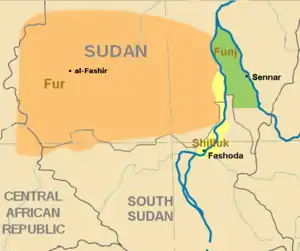Taqali
Taqali (also spelled Tegali) was a state in the Nuba Hills, in modern-day central Sudan. Unlike the surrounding Kordofan, the uplands of the hills were quite moist and suitable for agriculture and a dense population. The state was centred upon the Taqali Massif, the highest part of the hills in the northeast of the region. Its early history is unclear. Oral traditions state it was founded many centuries ago at the same time as the Kingdom of Sennar came into being. Some scholars doubt these tales and believe that the state did not come into being until the late eighteenth century (between 1750 and 1780), and that the early rulers on the king list are semi-mythological.[1]
Kingdom of Taqali | |
|---|---|
| 1750–1969 | |
| Common languages | Tegali language |
| Makk of Taqali | |
| History | |
• decline of the Kingdom of Sennar | 1750 |
• Taqali conquered by Sudanese Mahdists | 1884 |
• British defeat the Mahdists and incorporate Taqali into Anglo-Egyptian Sudan | 1889 |
• creation of the Republic of Sudan | 1969 |

History
Janet J. Ewald has argued[1] that the first true ruler of Taqali was Muhammad wad Jayli, and that he and his son Ismail of Qaqali forged the state. Some believe[1] it was formed during the period of disorder in the Kordofan when the Kingdom of Sennar was declining and Darfur was growing in power. Muhammad began the process of uniting the region. He was succeeded as Makk by his brother Umar. Umar was overthrown, however, by Ajaid, the queen mother, and Ismail around 1783. Ismail took over and further expanded the state, taking control of the "99 hills" of the region. His son Abakr peacefully succeeded him, but after this the state was beset by conflicts over the succession through much of the period from 1840 to 1880.
Despite its small size, the Taqali state remained independent of its more powerful neighbours. While the Nuba Hills were well suited to agriculture they were surrounded by the arid Kordofan. This region was far too dry to support a large army and only small expeditions could be launched. The rocky terrain of the Taqali Massif served as natural fortifications. The Kingdom of Sennar exerted enough pressure that Taqali sent annual tribute, but never conquered the area. When Sennar was destroyed by the Egyptian invasion of 1821, the situation continued. The Egyptians launched three separate attacks against Taqali, but all of them failed. Eventually an agreement was reached whereby Taqali would remain de facto independent but would pay a nominal tribute and be officially included within the Egyptian Sudan.
The state was finally conquered by the forces of the Mahdi Muhammad Ahmad. Makk Adam prevaricated between the British and the forces of the Mahdi, professing his support for both but aiding neither. In 1883 the Mahdi decided that Taqali had to be conquered. The subsequent offensive advanced further than previous ones, and in July, 1884, Makk Adam was captured, and he eventually died in captivity. Insurrections continued in Taqali and Hamdan Abu Anja was dispatched to defeat the resistance. This was done though much pillaging and destruction of the region.
With the defeat of the Mahdists, the Makk of Taqali were restored to power, but they were now closely controlled by the British. Taqali proved a useful ally and the British gradually gave it more territory to control and administer. This continued with the independence of Sudan in 1956. The administrative power of the state was finally done away with after the 1969 coup. The Makk of Taqali, though having no political power, remains a ceremonial leader to the people of the region to this day.
Royal family
The title of the ruler of Taqali was Makk (or Mek, "king"), possibly Arabic but more like an Arabized word of Merotici or Ge'ez origin. The tributaries of the Makk of Taqali were known as mukūk al-ʿāda (sing. makk al-ʿāda), "customary kings". In Taqali, the son of a makk was a wad al-makk (pl. awlād al-makk), and the son of a daughter of the makk was an arbāb (pl. arābīb). The arābīb were usually prominent councilors of the makk and the arābīb al-thamāniyya (eight arābīb) were a special council that met in the palace. An arbāb could sometimes pass his rank on to his sons. Likewise, the title of wad was sometimes bestowed on trusted slaves or servants. All awlād were eligible to be elected Makk. A wad who was given a territory from which to draw revenue was an ahl al-ṭāqīyah, one who wore the ṭāqīyah, a headdress associated with rule.[1]
A woman who bore a son to the Makk was known as an artiyya (pl. artiyyāt), a term not of Arabic origin. They attained the highest rank among the women of the royal household, each supervising her own household of surriyyat (concubines) and khaddama (maidservants).[1]
Mukūk of Taqali
- Muhammad al-Rubatabi
- Jayli Abu Jarida
- Sabo of Taqali
- Jayli Umara
- Jayli Awan Allah
- Jayli Abu Qurun
- Muhammad wad Jayli, c. 1750
- Umar I, to 1783
- Ismail I, 1783 to 1800
- Abakr I, 1800 to 1820
- Umar II, 1800 to 1835
- Ahmad, 1835 to 1840
- Maryud, 1840 to 1843
- Nasir, 1843 to c. 1860
- Adam I, c. 1860 to 1884
- Interregnum, 1884 to 1898
- Jayli, 1898 to 1916
- Abakr II, 1916 to 1920
- Adam II, from 1920 to an unknown date; one source claimed he was still ruling in 1990.
References
- Janet J. Ewald (1990). Soldier, Traders, and Slaves: State Formation and Economic Transformation in the Greater Nile Valley, 1700–1885. Madison: University of Wisconsin Press. ISBN 0-299-12604-8.
